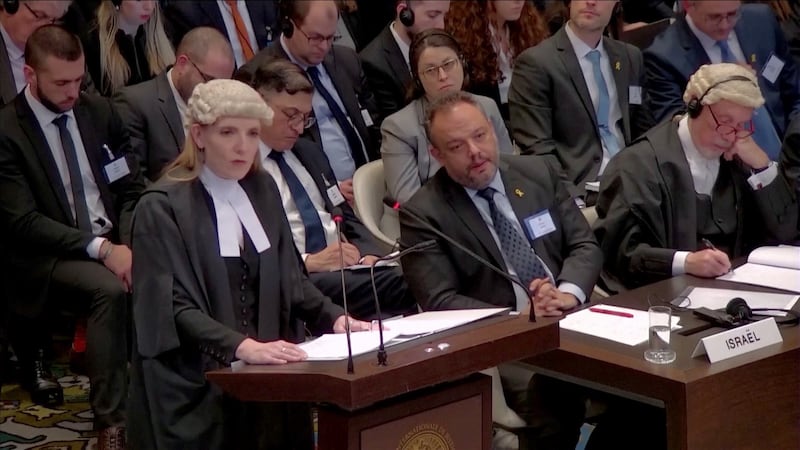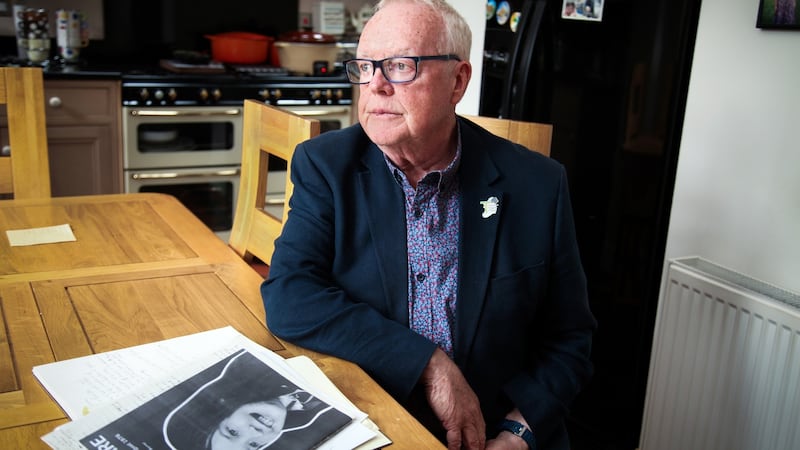“Well, Blinne, do something about it.” That was the response of Blinne Ní Ghrálaigh’s mother, Nessa, when her then 12-year-old daughter tearfully asked her why no one was held accountable for the killing of a girl the same age as herself.
It was sometime in the late 1980s when Ní Ghrálaigh found a pamphlet in her mother’s bookcase about Majella O’Hare, who was shot in the back by a British soldier as she walked with other girls to church on a country road in Co Armagh in 1976.
Ní Ghrálaigh was very influenced by the attitude of her “straight-talking” mother, a teacher, to any injustice or setback. That, she says, was not to “wallow in it” but “get on with it, turn it around, try and be the impact that you want to see”.
Ní Ghrálaigh kept the pamphlet and framed it above her desk after completing her barrister traineeship at Matrix Chambers in London in 2006.
READ MORE
Her mother’s words continue to strongly resonate with her and her legal career is focused on “doing something about it”. A passionate advocate for human rights, Ní Ghrálaigh, a king’s counsel and member of the bars of England and Wales, Ireland and Northern Ireland, came to global attention when she stood before the International Court of Justice (ICJ) this year to present South Africa’s case accusing Israel of genocide in Gaza.
“I am extremely proud of the role I played in the genesis and conduct of the South Africa case,” she says. “It was the honour and privilege of my life as a lawyer and as an Irish person to have been entrusted to advocate for South Africa before the court on the part of the bruised and battered Palestinian people. I very much felt the weight of history and the weight of responsibility in stepping up to the podium.”
She was “bowled over and humbled by the outpouring of support, love and pride” she received from Irish people after her role in the case was announced.
One message was from a man who attached a photograph of him, his wife and their daughter at her mother’s grave in Co Mayo, saying he felt compelled to make the journey to say a prayer for her mother “and to thank her for having inspired me to do the work I do”.

Ní Ghrálaigh has now “stepped back” from the South African case but not from the matters at issue. Her current caseload includes a legal challenge by Palestinian NGO Al-Haq, supported by Galway-based Global Legal Action Network, to Britain’s export of weapons to Israel. Earlier this month, British foreign secretary David Lammy announced Britain was halting some exports to Israel, just days after the legal team threatened his government with further proceedings, including for temporary injunctions.
Ní Ghrálaigh welcomes Ireland’s decision to intervene in the South African proceedings to broaden the definition of genocide on the premises of the stated “collective punishment of an entire population”.
“An intervention by Ireland in the context of the withholding of humanitarian aid, effectively famine as genocide, that is extraordinarily powerful.”
Given her expertise on the issues, Ní Ghrálaigh could make an important contribution to Ireland’s case. Asked about that prospect, she responded she had not been approached about Ireland’s intervention but, having acted in international forums for various other states in her career, “it would be wonderful to have the opportunity to represent Ireland in that way one day.”
Her concern about the situation in Palestine is long-standing. She spent months in the West Bank training Palestinian lawyers and law students about engaging with UN special procedures and documenting war crimes, and subsequently participated in a legal fact-finding mission to Gaza in 2009, immediately after Israel’s large-scale attack Operation Cast Lead.
Ní Ghrálaigh and her older sister Muireann had a somewhat “nomadic” early childhood between London, her mother’s native Dublin and Co Mayo, where her father was from and her mother too had strong roots.
“The part of Mayo I’m talking about is a little slice of heaven called Belderrig on the Wild Atlantic Way”. It was there she learned to swim, ride a bike and was “immersed in Irish history and the Irish language”. A big regret now is her loss of Irish but “a long period of re-immersion in the Gaeltacht” is on her “bucket list”.
Her mother, a graduate of Dublin’s Trinity College, ultimately settled in London with her daughters, who received most of their primary education there but retained their Irish identity, attending Irish language, dancing and music classes.
“Irish identity was central to our upbringing in London, it wasn’t in any way an insular upbringing. That was one of the things that was fantastic about my mother.” The girls were taken to many multicultural events and had “the run of London”, getting to know its museums and galleries “like the backs of our hands”.
Her mother remained “very immersed” in what was going on in Ireland. “My cousins were in Derry, what was happening in the North was very close to her heart. People often ask me why I specialise in protest law. It might be because one of my earliest memories is being in a buggy on a protest in London with my mother.”
The 1980s and early 1990s could be a difficult time to be Irish in London, she recalls. “There was a lot of overt racism, including anti-Irishness. They wanted to change our names in primary school, instead of learning how to pronounce them, as just a minor illustration.”

Not long after reading the Majella O’Hare pamphlet, Ní Ghrálaigh began visiting the Old Bailey to watch criminal cases and was “completely drawn to the theatre of it”.
“We had no lawyers in the family, it was all teachers, so I’m not sure I saw myself there. I went back there any opportunity I had to watch and take notes. We didn’t have a TV so I had to amuse myself, like my own personal crime drama.”
Her Old Bailey visits abruptly ended when a guilty verdict met an angry response, with “huge men” coming out of the courtroom “flailing around and shouting”. Ní Ghrálaigh, queuing outside, took “an almighty blow to the head”.
The next time she attended the Old Bailey was more than a decade later as a trainee barrister.
The girls’ secondary schooling was in a convent boarding school in France. Their mother, “a bit of a Francophile”, had found “great solace” in her time as a boarder at Dublin’s Mount Sackville school, says Ní Ghrálaigh.
After her return to England, Ní Ghrálaigh studied Modern and Medieval Languages at Cambridge which she helped fund through bar work, child-minding and other jobs. “French and Latin were my languages. It turns out they are the two languages of international law. I couldn’t have planned it better if I had tried.”
[ Who is the Irish lawyer arguing for South Africa’s genocide case against Israel?Opens in new window ]
Her prowess in French was evident when opening the South African case partly in French before the ICJ.
After graduating, she worked for two years in the London office of a US-based think tank to save money to pursue a legal qualification. The sudden death aged 24 of her best friend, Mary-Frances, prompted her to take the plunge. She quit her job and wrote to the human rights NGO British Irish Rights Watch (BIRW) and three law firms saying she wanted experience in human rights law and would work for free.
Within days, she had work with BIRW as an intern. One of her first tasks was to ensure the organisation had documented every killing during the Troubles, “an utterly heartbreaking task – reading through an account of each and every one of the over 3,700 conflict-related deaths, that would either have made you run a mile or just confirm that something needed to be done”.
She got a paid paralegal position with one of the law firms and combined that with law studies until she took up an offer from BIRW a year later to be its independent observer at the inquiry in Derry into the 1972 Bloody Sunday killings.
Having survived a bedroom ceiling in a rented house in Derry collapsing on top of her, she spent a year listening to “brilliant” barristers advancing the families’ cases before working another year on the inquiry with the law firm Madden & Finucane.
Now resolved on a bar career, she returned to London, completed her studies and was called to the bar in 2005. She has developed an extensive practice across human rights, public international law, criminal law and public law and has received several awards. She has an LLM from New York University and a Visiting Fellowship at Harvard Law School.
An expert on protest law, her successes include acquittals for two activists arrested for attempting to decommission Typhoon jets to be used in the bombing of Yemen, and for the “Stansted 15″, who prevented a deportation flight from taking off with victims of trafficking on board. She represented one of the “Colston four”, all acquitted on the basis of defences she advanced, of a range of charges over toppling a statue in Bristol of slave trader Edward Colston.

She has worked on numerous Troubles-related cases on all sides, including the “Hooded Men”, 14 men subjected to torture during internment without trial in 1971, and recalls the Police Service of Northern Ireland delivering an apology, as a result of the case, in June 2023 while one of the men, Joe Clarke, was dying.
Ní Ghrálaigh has no “starry-eyed notions” that the law can resolve all but believes it can make a difference.
“Law is not the only tool, but it is one of the tools by which we can attempt to prevent atrocities or to hold those responsible to account. The alternative is to give up, to do nothing. I have to admit to regularly feeling overwhelmed reading about the horrors of Gaza and elsewhere day in, day out, but how much more overwhelming must it be to live it? All that you can do as a lawyer is to try and do something.”
She is troubled about violent anti-immigrant protests in Ireland and across Europe but, as a specialist in protest law, her view is that states do not require additional or emergency powers to deal with those.
“The European Convention on Human Rights is very clear that, where protesters have violent intentions, incite violence, reject the foundations of a democratic society, the very rights provided for in the convention, then the rights of freedom of speech and freedom of expression are not even engaged.”
Setting fire to hostels or physically attacking people, “who have fled untold horrors”, are not actions to which the rights of freedom of speech and to protest apply, she says. Even if engaged, those rights “are very much qualified rights and can be restricted where it is necessary and prescribed by law, including for the protection of the rights and freedoms of others”.
She finds it “profoundly shocking”, as a member of the diaspora, to read about recent anti-immigration protests in Dublin. In her view, the poem You Don’t Get To Be Racist and Irish by artist Imelda May says it all.
“There’s one line that sticks in my head: ‘You don’t get to be proud of your heritage, plights and fights for freedom while kneeling on the neck of another’,” Ní Ghrálaigh says.
Among all the cases she has worked on, being asked by a solicitor to look at an old file on behalf of a client whose sister had been killed stands out. The client was the brother of Majella O’Hare.
“I dearly wish that my mother had lived to hear that part of the story. I have, however, since met Michael O’Hare, and told him of the impact his sister has had, and continues to have, on my life. She may have only lived 12 years but I consider my work to be very much part of her legacy.”



















